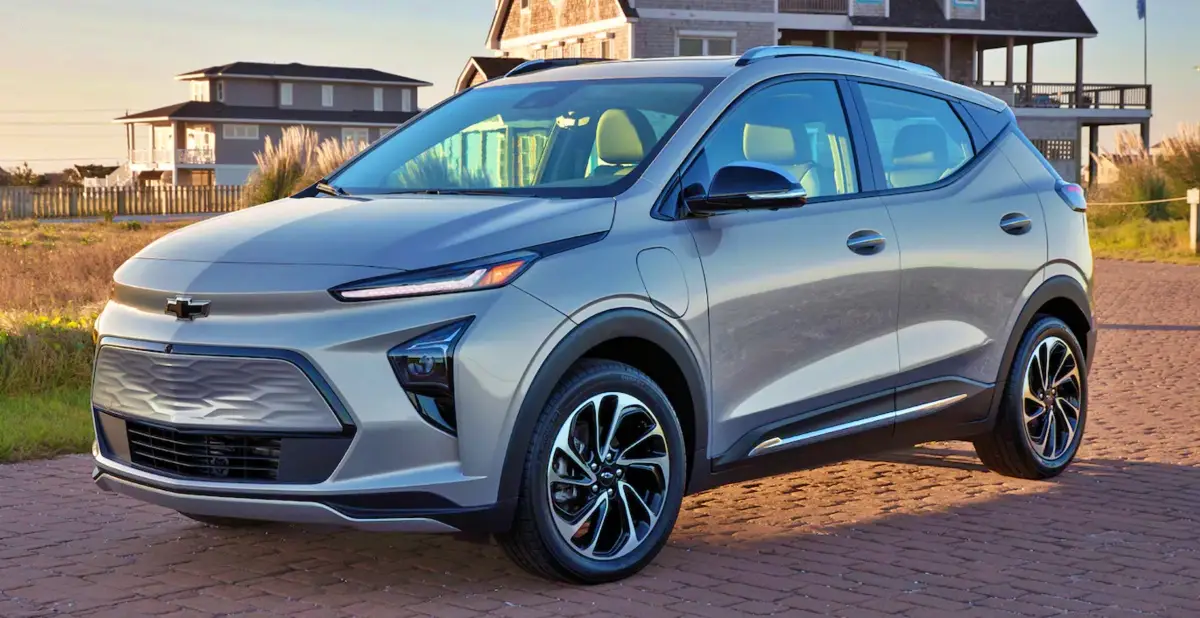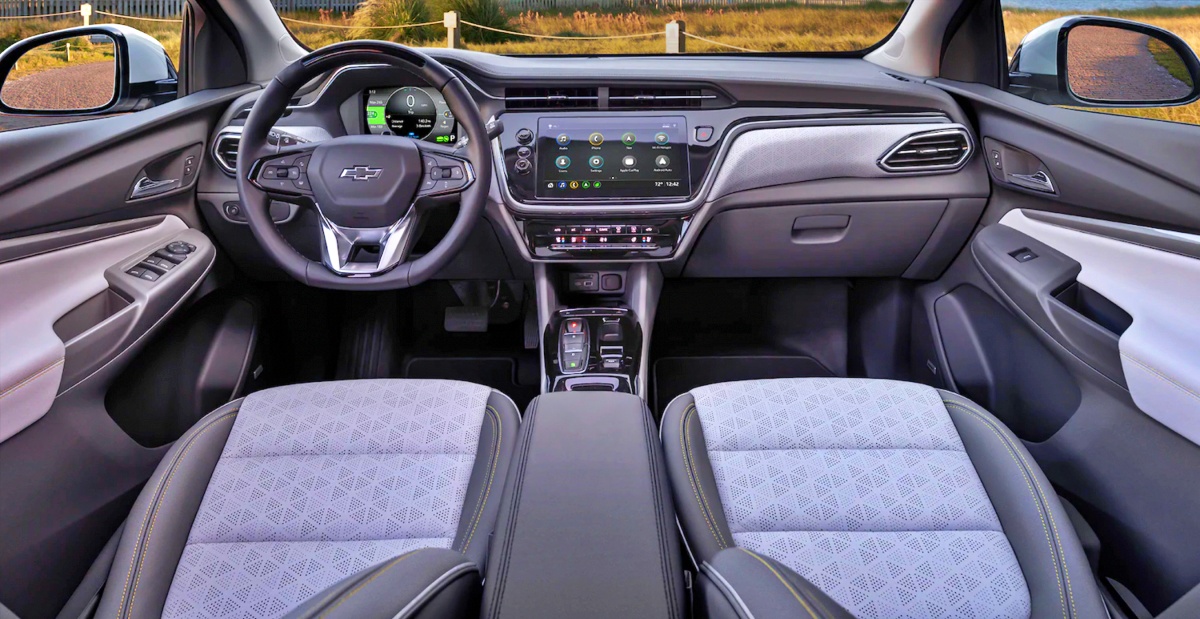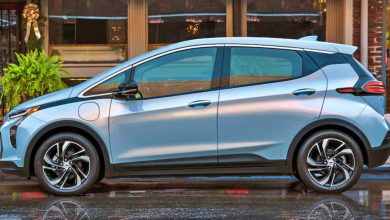2023 Chevy Bolt EUV: What We Know So Far
2023 Chevy Bolt EUV
2023 Chevy Bolt EUV – The new Chevy Bolt EUV is not much different from the standard Bolt EV hatchback; These twins are clearly more paternal than fraternal. However, some of the things that separate the chevy compact EV actually make a significant difference.
We hope for 2023 Chevy still carries the same concept as the previous model with little change.
2023 Chevy Bolt EUV

Both Bolts ride on the same platform and use the same electric powertrain. Their updated exterior design is basically identical, although Chevy says that bolts don’t really share any sheet metal.
The EUV looks much shabbier than the previous Bolt, with sleek LED lights on the front that double as sequential turn signals, equipped with the standard LED headlights below. The sleek taillights flank the Bowtie badge on Bolt’s hatch, although this only serves as a light on; The LEDs below the base of the hatch opening are the actual brake lights and blindfolds.
Chevy Bolt EUV Specifications
The new EUV is 6.2 inches longer than the regular Bolt EV, with a wheelbase of 3.9 inches longer. The EUV is also 0.2 inches taller and 0.2 inches wider than the smaller Bolt, but none of those improvements make a real difference. The only other distinguishing factor is the side rail circuit on the EUV roof. The 17-inch wheels seen here are used on both models.
One of the main benefits of that long wheelbase is more legroom. The EUV has an additional 3.1 inches of legroom for riders in the back seat, and thanks to the EV architecture flat floor, there’s plenty of room to lie down.
Bolt’s upright shape means there’s plenty of headroom as well, although that’s never been an issue with that old car. Even so, a narrow stance will still make you occasionally swiping your shoulders and elbows with your passengers, especially if you include, say, fatter carriages.
2023 Chevy Bolt EUV Engine
All Bolt EUVs are equipped with the same powertrain: a 200 hp electric motor and front-wheel drive. All-wheel drive is not an option. Acceleration should be good thanks to the instantaneous power distribution attached to the electric motor.
Regenerative braking allows the steering of one pedal while taking back energy to help expand the range of the Bolt EUV. The electric motor delivers dashing Bolt EUV acceleration, and although this may not be the fastest electric SUV, we estimate that it will reach 60 mph in a respectable 7.0 seconds. The handling is competent, if not too thrilling, and the comfort of driving is pleasant, even on damaged sidewalks.
The highly compact powertrain delivers cubic footage of passengers and cargo similar to the Bolt EUV Trailblazer in a much smaller body than the Trax.
But because the price is more in tune with the larger and more luxurious Blazer, and buyers don’t have the all-wheel-drive option in any Bolt, salespeople need to dream up some new arguments about the convenience of charging at home, simplicity of care, etc. if they’re going to move the BOLT EUVs.
Range, Charging, and Battery Life
All Bolt EUVs are equipped with a 65.0-kWh battery, which Chevrolet estimates will provide a driving distance of 250 miles on a full charge. That figure competes with most other electric SUVs, though tesla’s Model Y comes with a larger battery pack that offers a range of 326 miles.
The Bolt EUV can be charged at a standard 120-volt household outlet, but buyers want to consider a 240-volt connection for faster home charging. The SUV is also capable of fast charging DC, which Chevy says can provide a range of up to 95 miles in just 30 minutes.
2023 Chevy Bolt EUV Interior
The Bolt EUV cab looks stylish and neatly trimmed. Flat-bottom steering wheels and push-button gear selectors are standard on all models, and upholstery features mischievous geometric patterns.
The Bolt EUV is longer, wider, and taller than the regular Bolt hatchback, and its rear seats are generous of that extra space, with rear-seat legroom growing by more than three inches. Although longer, EUV offers slightly less cargo space, we expect most drivers will still find enough space for luggage, groceries, and other cargo.
The example of a Premier trim with a two-color interior certainly gives a great first impression. Contrasting yellow stitching and white piping on the seats, not to mention triangular perforations on the upholstery and dashboard inserts, give it a very luxurious look.
Soft-touch stitching materials on the dashboard and doors look and feel pleasant. There is good ambient lighting under the accent lines on each door and on the dashboard. The center screen looks as big as it is practical in a car this small.
The larger Bolt EUV is actually smaller than both in terms of cargo capacity, though only. The EUV has 16.3 cubic feet of cargo space behind the rear seat when the seat is upright, which extends to 56.9 cubic feet if folded flat.
The smaller Bolt EV offers 16.6 and 57.0 cubic feet of space, respectively. Again, a very small difference. Even so, bolt still offers more luggage space than Hyundai Kona Electric, Kia Niro EV, and Nissan Leaf.
We hope the Bolt EV and EUV 2023 have some nice interior updates, starting with a more attractively designed dashboard and better materials throughout the cabin. The seats are more comfortable, climate control is easier to use, and there is a new electronic push-button shifter in the console.

Infotainment and Connectivity
A large 10.2-inch digital gauge screen and a 10.2-inch infotainment touchscreen with integrated climate control are both standards. A number of connectivity features are available, including Apple CarPlay, Android Auto, Amazon Alexa, and integrated Wi-Fi hotspots.
Bolt EUV can also communicate with the driver remotely via a smartphone app, which can be set up to provide charging alerts and connect to nearby charging networks.
Chevy Bolt EUV Driving
An extra 6.3 inches and 90 pounds relative to the junior Bolt is unknown from the driver’s seat. The floor was, and the two front tires (Michelin Energy Saver A/S in size 215/50R17 as before) struggled for grip, especially when turning.
The car travels at a speed that always seems faster than the suggested time of about 6.5 seconds 0-60. A button activates the one-pedal driving mode, which provides enough deceleration to slow down most normal driving conditions; The number of people would appreciate that there is 214 percent more retardation than in Normal mode. Not enough? Drag the regen paddle on the left side of the steering wheel to increase it by more than 300 percent.
The steering feels as rheostatic as ever, even in Sport mode, which cuts the assist by about 20 percent, but the simple front strut/torsion-beam rear suspension reacts with certainty and with reasonable vigor.
The mass and rigidity of the low-mounted battery undoubtedly contribute to Bolt’s flat handling, and toned body feel. The quality of driving seems to suit this price class—sturdy, pliable, never too flashy. Is Will simply moving the motor backward improve the dynamics of the Bolt? Definitely.
If the name doesn’t automatically ring the bell, the supercruise is an excellent hands-free driver-assistance technology from General Motors that first debuted on the Cadillac CT6 sedan (now deceased).
The Bolt EUV marks the first time a Super Cruise has been offered on a Chevrolet vehicle and serves on more than 200,000 previously mapped highway miles across the United States and Canada.
No, the Super Cruise Bolt EUV version won’t change lanes like the new Cadillac Escalade, but it’s one of those technologies that completely separates the Bolt EUV from other electric vehicles. The only system that even came close was Tesla’s Autopilot, which, despite its name, was not at all.
At Bolt EUV, Super Cruise is a lot of fun. Simply set the adaptive cruise control and tap the steering wheel icon, and GM technology takes the steering, braking, and throttle inputs, with sensors attached to the steering column to ensure you pay attention.
The Super Cruise works very well with the bolt EUV’s smooth electric powertrain, too, easily applying more torque for acceleration and using the regeneration available to slow down.
By the way, the Bolt EUV has a paddle on the left side of the steering wheel that serves as an on-demand regen switch for braking. There is also a special one-pedal driving mode that you can turn on and off with the buttons on the center console.
Another great benefit of longer wheelbases is that the Bolt EUV has much better ride quality than standard hatches. More space between the wheels reduces the wobble-bobby feeling that many short-haul cars have in the city or over highway expansion connections.
EUV is really more fun to drive – during the day Los Angeles traffic. I can’t imagine light steering and narrow tracks will make Bolt move wildly on winding roads, but then again, that’s not the reason people bought this stuff in the first place.
Chevy Bolt EUV Powertrain
The New Bolt EUV has the same electric powertrain as the smaller Bolt EV, the same powertrain as the old model. The 65-kilowatt-hour battery delivers power to the electric motor on the front axle, a total output of 200 horsepower and 266 pound-feet of torque.
Chevy does not offer dual-motor, all-wheel-drive setups; You have to step into something like a Ford Mustang Mach-E, Tesla Model 3, or Model Y.
Each Bolt EUV is equipped with a two-level charging cable that has a replaceable plug, allows the owner to connect to a standard 120 volt Level 1 charger or a 240 volt Level 2 outlet, and is capable of charging 7.2 kW. (This cable is an option at the Base Bolt EV.)
On the Level 2 charger, Chevy says it will take about 7 hours to fully charge. Both Bolts are also capable of charging dc fast, and the Bolt EUV can gobble up 95 miles worth of electricity in about 30 minutes.
Regarding the critical range question, the Bolt EV and EUV remain competitive with other compact electric hatchbacks. The smaller EV is expected to return a range of 259 miles on a full charge, while the larger EUV lowers that figure to 250 miles which can still be respected. Those numbers went well compared to the Hyundai Kona Electric (258 miles), Kia Niro EV (239 miles), and Nissan Leaf Plus (226 miles) mentioned above.
How Can Far Bolt EUV Charge?
Official EPA results are not expected until a closer launch this summer, but GM’s internal testing says it is 250 miles away. The 63-mile test drive I spent aggressively investigating the acceleration limit or gliding at 75 mph (the speed that generates a warning yellow ring around the speedometer) eliminated 75 miles from the indicated range.
Doing some math based on the start and end screens shows that the entire battery that is valuable for this driving can produce a distance of about 175 miles. One of Bolt’s best-executed features is a reconfigurable instrument cluster, and an infotainment screen can be configured to provide all the information the driver needs to maximize range or better understand how driving behavior and the use of additional accessories affect range.
How to Charge EUV Bolts?
The standard charging cable that came with all 2022 Bolts has a new twist: It’s plugged into a standard 110-volt outlet or a NEMA 14-50 outlet. Such outlets usually power an electric stove or oven, so if you do not already have such an outlet in your garage, the Chevy will bear the cost of installing it.
For the cable to produce a full 7.2 kW, the home system must be able to support an 8-gauge cable and a 40-amp fuse. Of course, the Bolt EV 2022and EUV onboard charger is now capable of receiving 11.5 kW of incoming AC power, so impatient homeowners who can swing 6-gauge cables and 50-amp fuses may want to look for their own higher-powered Level 2 charger.
Full charging will take about 7 hours on a Chevy-supplied 240-volt charger, and the Bolts still receive DC fast charging, which promises to add 95-100 miles to a battery that runs out in half an hour.
The lights at the top center of the dashboard (and around the Launch Edition model charger) keep you informed of the progress of charging, blinking periodically: A single blink shows 0-25 percent charging, two winks means 25-50 percent, and so on to die to show 100 percent charging.
2022 Chevy Bolt EUV Price
Bolt EUV 2022 starts at $33,395 including destination, not taking into account available tax credits, which are cheaper at $4,220 than the Bolt EV 2021. The most expensive and fully loaded EUV Launch Edition (Super Cruise, sunroof, special wheels, and so on) reached $43,495. No matter how you slice it, the Bolt EUV is reasonably priced for a compact EV.
Meanwhile, the 2022 regular Bolt EV starts at $31,995 (again, including goals but excluding available incentives). Yes, that’s an extra saving of $2,000, but the Bolt EV has less space for passengers, is uncomfortable on the road, doesn’t have a standard dual charging cable, and locks you out of GM’s awesome Super Cruise technology.
Chevy believes there’s room in its portfolio for two bolts to coexist, but I honestly don’t know why you’ll get a smaller version. The new EUV is a bigger and better version of the Bolt already preferred, and with great technology and low prices, it makes it a very attractive way to use electricity.

